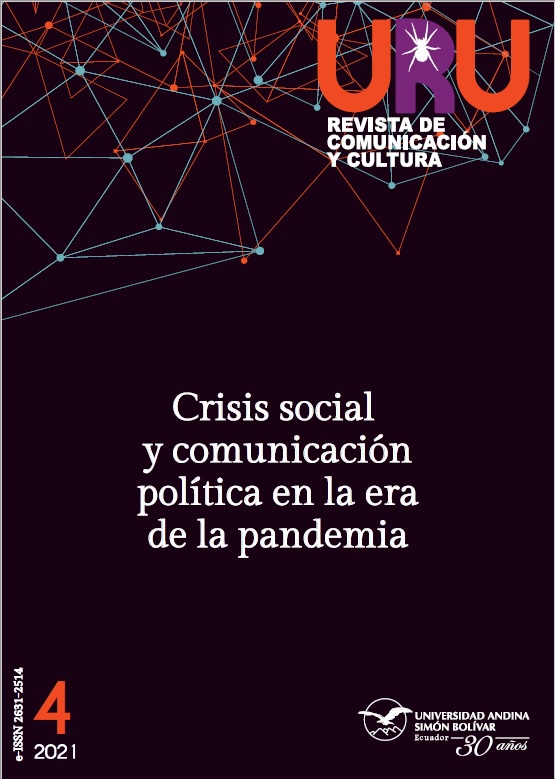Digital Journalism and Facebook during COVID-19 in Peru and Ecuador
DOI:
https://doi.org/10.32719/26312514.2021.4.8Keywords:
Social networks, pandemic, information, journalism, Andean CommunityAbstract
El Comercio in Ecuador and in Peru are considered two reference media with significant audiences. Both, although their names correspond, use different speeches when it comes to issuing information according to the characteristics of their users, who differ when interacting with content on various topics. The pandemic around COVID-19 changed coverage routines. Both newspapers focused a large part of their publications on exposing information about the virus and the reactions of each government. The objective of this study was to identify the components of the journalistic discourse with the greatest relevance, about the pandemic, exposed by both media from the first cases of COVID-19 in Peru and Ecuador, as well as to determine the reactions of the audiences accordingly. of interactions with the content presented. The approach was qualitative from a case study.
Downloads
References
Amnistía Internacional. 2021. “Coronavirus: No solo está en juego el derecho a la salud”. Amnistía Internacional Perú. Accedido 24 de mayo. https://bit.ly/38RUZnS.
Aparici, R., y D. Marín. 2019. La posverdad: Una cartografía de los medios, las redes y la política. Barcelona: Gedisa. https://bit.ly/3u7P0De.
Cedatos. 2020. “COVID-19 cambió la vida y expectativas de los ecuatorianos. Apreciaciones de la población al 16 de abril de 2020”. Cedatos. https://bit.ly/38MJldV.
CEPAL. 2020. Panorama social de América Latina 2020. Santiago de Chile: CEPAL.
Cruz Valdivia, C. 2018. “Periodismo digital: Experiencia en el site Dakar 2013 y la convergencia de redacciones en el diario El Comercio”. Tesis para optar el título profesional de licenciado en Periodismo, Universidad Nacional Mayor de San Marcos, Perú. https://bit.ly/3pG745m.
EC Defensoría del Pueblo. 2020. “La Defensoría del Pueblo exhorta y exige al Gobierno Nacional dejar sin efecto las resoluciones que determinan que el coronavirus no constituye un accidente de trabajo".
Defensoría del Pueblo Ecuador. 29 de abril. https://bit.ly/3fY5WH1.
EC Ministerio de Salud Pública. 2021. “Comunicados oficiales del Ministerio de Salud Pública del Ecuador”. Ministerio de Salud Pública. Accedido 24 de mayo. https://bit.ly/2Ka7Rw2.
El Comercio. 2020. “Presidente declara emergencia sanitaria en Ecuador por el coronavirus covid-19”.
El Comercio. 17 de marzo. https://bit.ly/3xOcwH5.
Elías, C. 2018. “Fake news, poder y periodismo en la era de la posverdad y hechos alternativos”. Ámbitos. Revista Internacional de Comunicación 40: 1-6. https://bit.ly/3fw6RQm.
Gargurevich, J. 1991. Historia de la prensa peruana, 1594-1990. Lima: La Voz Ediciones.
Grupo El Comercio. 2006. “Manual de estilo”. Grupo El Comercio. https://bit.ly/3hRrlEm.
—. 2012. “Manual de buenas prácticas”. Grupo El Comercio. 7 de mayo. https://bit.ly/3uhGt0i.
Guerrero, S. 2020. “Coronavirus en Ecuador: Una opinión desde la academia”. La Granja. Revista de Ciencias de la Vida 32 (2): 127-33. https://doi.org/10.17163/lgr.n32.2020.10.
Hootsuite. 2019. “The global state of digital in 2019”. Hootsuite. https://bit.ly/3wx7XR2.
Jaque, C., M. Tarrillo, J. Ramos, G. Pasapera, y L. Vásquez. 2020. “Aspectos económicos y de salud en tiempos de cuarentena por COVID 19 en población peruana, año 2020”. Revista de la Facultad de Medicina Humana 20 (4): 630-9. https://bit.ly/2MuwDrA
Jenkins, H. 2006. Fans, Bloggers, and Gamers: Exploring Participatory Culture. Nueva York: NYU Press.
Johns Hopkins University. 2021. “Coronavirus Resource Center”. Johns Hopkins University. Accedido 24 de mayo. https://bit.ly/3iUvoy7.
Katamaya, R. 2014. Introducción a la investigación cualitativa. Lima: Universidad Inca Garcilaso de la Vega. https://bit.ly/3u8fzIo.
Llerena, L., y N. Sánchez. 2020. “Análisis a la identificación de redes de contagio y aislamiento social como estrategia de prevención en salud pública frente a la pandemia
COVID-19 (coronavirus)”. Figshare. https://doi.org/10.6084/m9.figshare.12110655.v1
Márquez, C., B. Moreno, y D. Ruiz. 2019. “Firma y presencia del gatekeeper en el periodismo ecuatoriano. Estudio de caso: El Comercio”. Revista Ibérica de Sistemas e Tecnologias de Informação
(E20): 670-82. https://bit.ly/3cjGifn.
—, N. Ulloa, y Y. Ramos. 2018. “Interaction Gap: From the Bit to the Resurgence of a New Information and Communication System”. En International Conference on Information Technology & Systems (ICITS 2018), editado por A. Rocha y T. Guarda, 1065-75. Springer. https://doi.org/10.1007/978-3-319-73450-7_101.
Montoya, R. 2020. “Quédese en casa, mano dura y democracia”. La Mula. 14 de mayo. https://bit.ly/2Lzad8B.
Navarrete, J. M. 2020. “Modernidad, Covid-19 y colonialidad en el Perú”. Notas Introductorias. Investigaciones Sociales 23 (43): 107-18. https://bit.ly/3iXB36u.
PE. 2020. Decreto Supremo N.° 044-2020-PCM (Normativa sobre Estado de Emergencia por Coronavirus). https://bit.ly/3t9kQ2H.
PE Defensoría del Pueblo. 2020a. “Reporte regional de Lambayeque y La Libertad al día 09.04.2020”.
Defensoría Peruana del Pueblo. https://bit.ly/2XL9a83.
—. 2020b. “Minsa debe asumir conducción de acciones de control del COVID-19 en Arequipa y Callao”. Defensoría Peruana del Pueblo. https://bit.ly/2LYgiek.
PE INEI. 2020. “Informe técnico. Situación del mercado laboral en Lima Metropolitana. Trimestre móvil”. Instituto Nacional de Estadística e Informática. https://bit.ly/3oVns1R
Perlman, S. 2020. “Another Decade, Another Coronavirus”. New England Journal of Medicine 382: 760-2. https://doi.org/10.1056/nejme2001126
Ramos, Y., C. Márquez, I. Argüello, E. Guzmán, A. García, y C. Acosta. 2020. “Aproximación al periodismo cuántico: La próxima revolución”. Revista Ibérica de Sistemas e Tecnologias de
Informação (E32): 532-45. https://bit.ly/2MDfETR.
Ramos Obregón, V. 2019. “La representación de las personas con discapacidad en cuatro periódicos de Lima: El Comercio, La República, El Peruano y Trome”. Tesis para optar el título profesional de licenciada en Periodismo, Pontificia Universidad Católica del Perú. https://bit.ly/3t0FPEZ.
Ruiz, G., y A. León. 2020. “Evolución de la enfermedad por coronavirus (COVID-19) en Ecuador". La Ciencia al Servicio de la Salud 11 (1): 5-15. https://bit.ly/3nS6j7C.
Salaverría, R. 1999. “De la pirámide invertida al hipertexto: Hacia nuevos estándares de redacción para la prensa digital”. Novatica 142: 12-5. https://bit.ly/36DHjvp.
Shanon, E. 1948. “A Mathematical Theory of Communication”. The Bell System Technical Journal 27 (3): 379-423. https://bit.ly/36om4NP.
Toffler, Alvin. 1992. La tercera ola. Barcelona: Plaza & Janés.
Vedral, V. 2018. Decoding Reality: The Universe as Quantum Information. Oxford University Press.
Wallace, A. 2020. “El coronavirus en América Latina: Así avanza la pandemia de covid-19 en la región". BBC News. 3 de abril. https://bbc.in/3yAgTXE.
World-O-Meter. 2021. “COVID-19 Coronavirus Pandemic”. World-O-Meter. Accedido 24 de mayo. https://bit.ly/2MhgOoe. 3 de enero de 2021.
Zhu N., Zhang D., Wang W., Li X., Yang B., Song J., Tan W. et al. 2020. “A Novel Coronavirus from Patients with Pneumonia in China, 2019”. New England Journal of Medicine 382: 727-33.
Downloads
Published
How to Cite
Issue
Section
License
ASSIGNMENT OF RIGHTS, DECLARATION OF CONFLICT OF INTEREST AND DISSEMINATION
The authors who publish in this journal accept the following conditions:
- Authors retain copyright and grant the journal the right of first publication, with the work registered under the Creative Commons Attribution-NonCommercial-ShareAlike 4.0 License, which allows sharing, adapting and attributing the work (see: Open Access Policies).
- Authors can make other independent and additional contractual agreements for the distribution of the article published in this journal (e.g., include it in an institutional repository or publish it in a book) as long as they expressly indicate that the article was published for the first time in Uru: Revista de Comunicación y Cultura. In the case of reproduction, a note similar to the following must be included: This text was originally published in the journal Uru: Revista de Comunicación y Cultura N ° -, year of publication.
- Authors are encouraged to publish their work on the Internet (e.g. on institutional or personal pages) in the final version published by Uru: Revista de Comunicaicón y Cultura as it may lead to a wider and faster dissemination of the published work.









